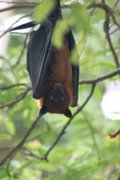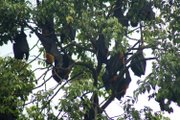One of the many myths propagated by Hollywood and which most people have come to believe must be that pythons are the most docile of reptiles. Away from Tinsel Town, the backstreets of some of Asian major cities or funfairs seemed to reinforce this. Chances are you would see pythons being handled quite easily although a bit heavily, adding more credence to the myth. In fact the more adventurous ones have been known to keep them as pets in their homes just to scare the hell out of unsuspecting friends. They are after all harmless creatures, according to the owners.
In the wild, pythons will lie coiled on the branches of trees and after selecting and successfully snaring their victims will grab them with their mouths and coil themselves around the targets. Using their tails for better leverage by holding on to the branches, they slowly pull the victims towards the tree and ever so slowly crushing the wind and life out of their prey, be they man or beast. It does not really matter that the pythons do not thoroughly messed up and meshed up your insides before devouring you because by that time you would be past caring whether your heads or rear ends enter first. By this stage victims would have already stopped breathing for quite a while from asphyxiation.
And what most people are quite unaware of is that pythons come in several versions for want of a better term. The Burmese version (Python molurus bivittatus) and the many other versions we shall merely refer to as the others. And the docile and seemingly harmless, albeit, gigantic snake that is handled quite easily is the Burmese version. The non-Burmese version, which I have had the pleasure of watching once, didn’t just slither around aimlessly but was quite ferocious. It had this ability to open its mouth to almost 180 degrees before randomly taking aim at parts of your anatomy worth taking shots at. Coupled with that are two rows of razor sharp teeth shaped very much like saws. Should the python be lucky with its target practice, then it could tear out chunks of flesh leaving certain parts of your esteemed self very much disfigured. And if anybody ever tells you pythons don’t have teeth, that person is talking rubbish and obviously had not really looked close enough. The snakes that don’t have teeth are boas. But then boas also give birth to their young instead of laying eggs like other snakes.
Of course, this is not to say that the non-Burmese python could not be handled. In the hands of experts they can, just as the case is with any type of snakes. Still I feel that there are easier ways to make a living than being a snake handler, although accountancy which pay hell of a lot more, may not be as exhilarating. Some people must be addicted to the adrenalin rush that comes with walking on the wild side daily just like others seemed to get a thrill out of riding their motorbikes on one wheel at traffic lights.
But make no mistake about it. Encountering a snake, the venomous ones that is (not counting pythons, boas and anacondas which are in a class of their own), can be as dangerous in the wild as it is at a funfair. No such thing as a cobra or king cobra with their venom glands (located just behind their eyes) being removed thereby rendering them harmless either. For without their venom such snakes would die as they are no longer able to feed and digest their food. What is probably done is that the handlers would extract the venom just before the show, thereby making them less fatal for at least a brief period of time.
I was told by a particular snake handler somewhere in Northeast Thailand that as part of his show he used to put the head of the king cobra in his mouth and grip it with his teeth. He had been doing that with the same snake for years so both were quite familiar with the trick. But one fine day that particular king cobra must have taken a sudden dislike for his breath and proceeded to sink its fangs into the man’s tongue. The man ended up in intensive care for a few weeks. The snake was returned to its cage without being harmed. It is taboo to kill a snake for the people of Ban Khok Sanga in Khon Kaen Province. The king cobras are always treated as friends. And with friends like that you certainly don’t need enemies, ever.
Meanwhile Chachoengsao Province, just to the north of Bangkok, is home to another type of creature, which some may find just as squeamish as snakes. These are the giant fruit bats or what some people call flying fox. They do indeed look like foxes with wings and are the size of chickens, the adults weighing at least more than a kilogram. The Thais call bats khang khao, roughly translated as the ones with the extremely smelly (in a fishy sort of way) chin. It is supposed to be an exotic cuisine in some kitchens. But I was told that when preparing a dish of bat curry or whatever, care must be taken never to break the saliva glands, otherwise the meat is useless because it is too smelly to eat. Thus the name khang khao. Some people have said their flesh tastes better than chicken and I fear I have to just take their word for it. But then again those who like to eat the meat of exotic animals always say that, be they dogs or frogs. Every meat on earth seemed to taste better than chicken meat, yet every body seemed to be eating chicken with such relish. All I can say is go eat a komodo dragon, then come back and tell me the meat tastes better than chicken meat.
There seemed to be nothing remarkable about these particular group of fruit bats if not for the fact that they seemed to be extraordinarily smart. They have chosen to make their homes on trees at the Wat Pho Bang Rak, thereby ensuring that there is almost zero chance of any of them ever finding itself as the main dish at some exotic dinner. They leave the temple compound before night fall to feed at the nearby forests which make up the Khao Yai National Park and return just before dawn to sleep hanging upside down. There must be thousands of them perched on the branches from batman and batgirl to bat mama, bat papa and bat kids. Being blind as a bat during the day, the bats allow you to get up close and photograph them. It couldn’t just have been survival instinct that told them a temple is a safe haven. It must be extra sensory perception. To kill any of these creatures, while they are in the temple compounds would have been a cardinal sin.
Another creature had also found temples to be safe havens. These equally clever species of catfish are found in rivers situated near temples. Unlike the bats, the fish are, however, more commonly seen. As they make their home in the temple area, again no one is allowed to catch these fish. They have become rather pampered, though, relying on kind tourists for their daily food of bread and fish pellets. Most have grown to a few kilos and would have fetched quite a price at the market. But unlike some of their distant cousins in Malaysia, they never venture beyond the temple areas. Somebody once pointed out to me that in Malaysia they are called ikan jelawat. In Thailand, they are more popularly known as the smart catfish.
Subscribe to:
Post Comments (Atom)



















2 comments:
Sawadee Krap Khun Somboon...
Intrigue when you pointed out my gaffe / faux pas re: the Carly Simon in my comment in Kak Ena's blog?
You are right because the conventional wisdom pointed to JT. In my haste, I forgot. But we'll never know will we? Some rock historians claimed it was Cat...
I take it you are Malaysian? Having lived in KB and all?
Man, I enjoy your travelogues. Khon Khaen bring back memories. As an oilfield professional, Khon Khaen was where I learned to drill holes. It was the Nam Phong gas fields for Esso if I remember right. It was also my introduction to Lao women since the borders were quite close... haha.
All the best, enjoy postings from a true pro, Sir. I do have a long way to go...
You didn't just drill holes in the ground, I hope. Yes, I must agree that Lao women can be quite charming.
Post a Comment